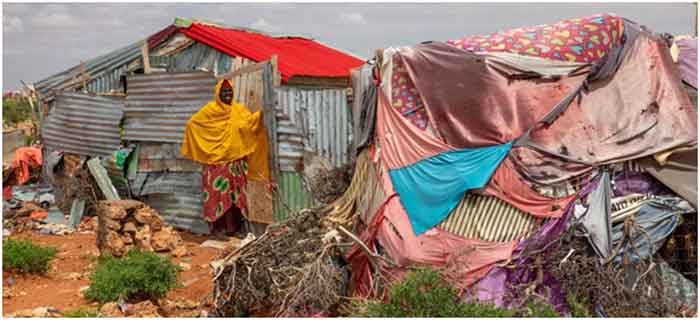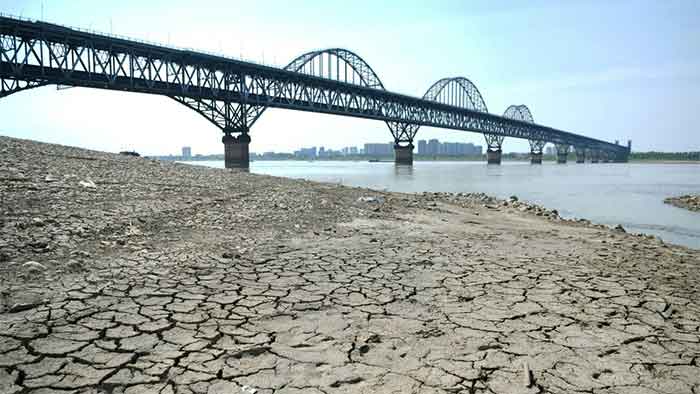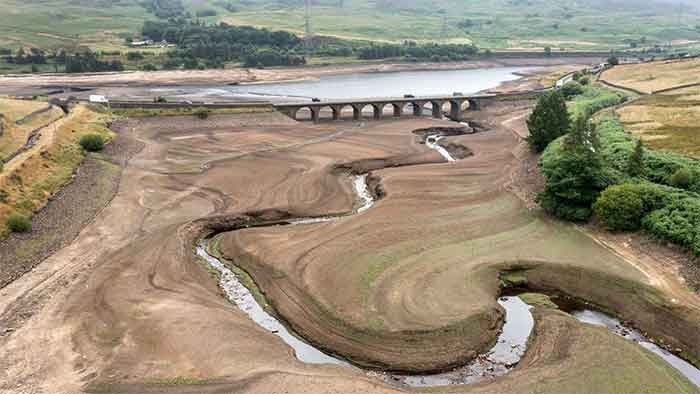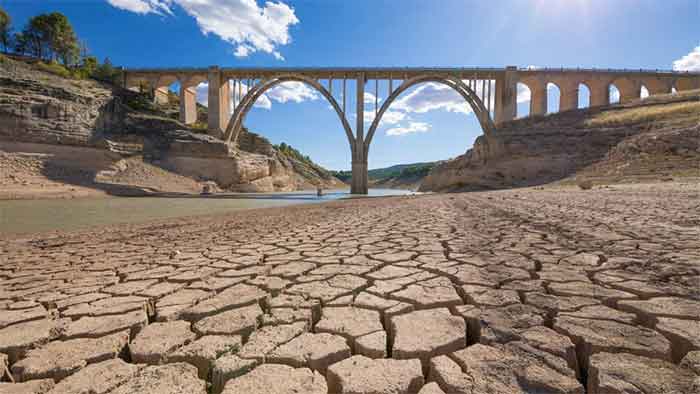
U.S. state Utah Gov. Spencer Cox (R) issued a declaration on Thursday that urges residents to pray for rain as the state experiences record drought.
At least 90% of the state is currently experiencing “extreme” to “exceptional” drought, the two worst categories, according to data from the U.S. Drought Monitor.
“I’ve already asked all Utahns to conserve water by avoiding long showers, fixing leaky faucets and planting water-wise landscapes. But I fear those efforts alone won’t be enough to protect us,” Cox said in a video.
“We need more rain, and we need it now. We need some divine intervention. That’s why I’m asking Utahns of all faiths to join me in a weekend of prayer June 4 through the 6th,” the governor added.
Cox has issued two drought emergency orders so far year.
Like most of the West, Utah is locked in the grips of a brutal drought that’s likely to worsen as the summer heat kicks in.
Climate change is increasing the severity and frequency of such events. Right now, more of the U.S. is in the most severe drought categories than at any time so far this century.
The Colorado River and its tributaries are approaching record-low flows this year, and the drought in the Colorado River basin, which includes Utah, could be the worst it has seen in 1,200 years, according to Bloomberg.
Water levels are getting so low in Lake Mead, on the Colorado River, that they’re likely to trigger a rare water shortage declaration, which would prompt cuts in water deliveries to several thirsty states, especially Arizona.
Worst Drought in Decades Escalates Threats across U.S. West
Another report said:
Almost three-fourths of the western U.S. is gripped by drought so severe that it’s off the charts of anything recorded in the 20-year history of the U.S. Drought Monitor.
Mountains across the West have seen little precipitation, robbing reservoirs of dearly needed snowmelt and rain, said Brad Rippey, a meteorologist and Drought Monitor author with the U.S. Department of Agriculture. The parched conditions mean the wildfire threat is high and farmers are struggling to irrigate crops.
Meanwhile, dropping water levels in Lake Oroville, one of California’s largest reservoirs, forced authorities to remove more than 100 houseboats, according to the Weather Channel.
Unlike the eastern U.S., in the West most water comes in winter months in the form of rain that gushes into reservoirs or snow that piles up on mountainsides. Last year, drought cost the nation $4.5 billion, according to the U.S. National Centers for Environmental Information. This year, what little snow that fell soon melted away and seeped into dusty ground rather than rivers, streams and reservoirs.
“We have never seen a drought at the scale and the intensity that we see right now, and it is possible that this may be the baseline for the future,” Elizabeth Klein, senior counselor for the Department of Interior told a Congressional hearing last week. “California is currently experiencing its third-driest year on record; the second two driest years on record, and the driest year since 1977.”
Through the end of April, 1.7 million acre-feet of water melted off California’s mountains, down from the normal rate of 8 million, Rippey said. In the last two years, there has only been 4 million.
“This is, by far, the worst recharge year in modern history,” Rippey said.
In addition to the drought figures, officials are concerned about the Colorado River, which powers hydroelectric plants and provides drinking and irrigation water across much of the Southwest and parts of Mexico. So much water is taken out of the Colorado, in fact, that it rarely ever makes it to its historical delta in the Gulf of California.
Based on paleohydrology, scientists say the Colorado is experiencing one of its driest periods in 1,200 years, Klein said.
California’s Epic Drought Is Parching Reservoirs and Worrying Farmers
Another report said:
California is an infamously thirsty place. But this year, even by its own standards, the state is shockingly, scarily parched. So far in 2021, the state has received half of its expected precipitation; that makes it the third driest year on record according to California’s Department of Water Resources.
This past week, as temperatures from Sacramento up to the Oregon border topped 100º Fahrenheit, the intense heat evaporated the remaining water at an astonishing pace, creating scenes more reminiscent of Hollywood-manufactured dystopias like Mad Max than the lush paradise Americans are used to envisioning on their West Coast.
At Folsom Lake, the enormous reservoir that supplies both drinking and irrigation water in the middle of the state, surface levels suddenly dropped to 68 feet below what they were at this time last year. By last week, boat slips that once floated were sitting on a dry lake bed with grass sprouting around them.
Folsom is hardly alone in its extremity. The long-lasting lack of precipitation is taxing reservoirs state-wide. On April 21, California Governor Gavin Newsom declared a drought emergency in two northern counties, Mendocino and Sonoma, where water levels had reached record lows. On May 10, Newsom extended the emergency declaration to encompass 41 of the state’s counties, which are home to roughly 30% of the state’s population.
And still the water supply shrinks. Nicasio Reservoir outside of San Francisco has been reduced to a cracked dried mud flat, while green algae grows at the edges of the San Luis Reservoir, just south of San Jose.
While California has experienced dry spells before, scientists say this one has been amped up by climate change.
Drought has afflicted the America Southwest for nearly two decades — the period from 2000 to 2019 was the second-driest in the area since at least 800 C.E. Researchers from Columbia University’s Lamont Doherty Earth Observatory estimated that man-made changes to the climate were responsible for 47% of the drought’s severity, in a study published in the journal Science last year.
Worse, the researchers predicted that the Southwest could be entering an era of mega-drought, a period when extreme water scarcity lasts for decades rather than years. For agriculture-heavy California that spells big trouble, especially the water-intensive crops such as lettuces and almonds the state is famous for producing.
In Bakersfield, which is home to some of the country’s most productive lands, farmers are irrigating just-budding nut trees and hoping for the best.
The California Aqueduct is a series of canals and tunnels designed to bring water to the Central Valley from the Sierra Nevadas, and is now desperate lifeline for farmers who have already overdrawn groundwater supplies. During times of drought, the ground in the area can sink as much as 13.7 inches a year as water is pumped out of it.
The Sierra Nevada snowpack was just 59% of average on April 1, when it’s normally at its peak.
But there are already dark clouds on the horizon. Last year wildfires burned across more than 4 million acres of the state, setting a new yearly record. Already Cal Fire, the state fire agency, is reporting that it expects another active season.
In mid-May, a fast-growing brush fire erupted near the Pacific Palisades neighborhood of Los Angeles, prompting mandatory evacuations.
A ‘megadrought’ may lead to water shortages for production of everything
Another report said
A megadrought in California is threatening to push food prices even higher.
The state is already facing its worst water shortage in four years and the its driest season has only just begun, according to data from the National Integrated Drought Information System (NIDIS).
As water levels continue to fall, farmers and ranchers will be unable to maintain key crops and feed livestock. As of Tuesday, nearly 75% of California was classified as in “extreme drought,” meaning the land does not have adequate water supplies to sustain agriculture and wildlife, according to the NIDIS.
While farmers have come to expect and prepare for droughts, this year has already been much hotter and drier than previous ones. Scorching California weather is drying up reservoirs, as well as the Sierra Nevada snowpack that helps supply them. The reservoirs are 50% lower than they should be in June, Jay Lund, co-director of the Center for Watershed Sciences at the University of California-Davis, told Associated Press.
The farmer’s plight could make products like almonds, avocados, and milk more expensive for shoppers as farmers struggle to produce crops of the state’s top exports. California produces over 25% of the nation’s food supply. California agriculture is a nearly $50 billion industry and is known for producing over 400 key commodities, according to the California Department of Food and Agriculture.
Dave Kranz, a California Farm Bureau spokesperson, told Insider it’s too soon to tell whether the drought will have a significant impact on grocery prices, but it is sure to be a “catastrophic” year for farmers. He said he’s already seen several farmers scaling back their crops and prioritizing ones that rely less on water supplies.
“A lot of factors play into the prices people see at stores,” Kranz said. “The payment that farmers receive for their crops is a very small portion of the price shoppers pay. Most of it comes from transportation, packaging, and marketing.”
The last time the state faced a drought of this magnitude, experts said shoppers could expect prices to rise about 3% and predicted the Californian agriculture industry could be handicapped for years, Gannett reported. During the 2014 drought, experts told CNBC prices for top California exports like avocados, berries, broccoli, grapes, and lettuce could rise anywhere from 17 to 62 cents, depending on the product.
Any potential price increases do not occur immediately or all at once. They are often felt long after the drought has already wreaked havoc on local farm crops, Annemarie Kuhns, a member of the Agriculture Department’s Economic Research Service, told the Des Moines Register in 2015.
“It takes time before the effects are seen at the retail level,” Kuhns said. “Once you see drought conditions start to improve you’ll see these effects further down the road.”
Droughts are nothing new for California farmers, who use conservation practices that reduce water runoff and allow moisture to enter the soil. Farmers also focus on crops that require less water, though about 40% of the 24.6 million acres of farmland in California require irrigation, Reuters reported. Many farmers told the publication that they are planning to leave large portions of their land unseeded due to this year’s drought.
The farms are allocated some water from the state, but this year the California Department of Water Resources reduced farmers and growers to 5% of their expected water allocation in March. Last month, Chris Scheuring, California Farm Bureau senior counsel, said it appears the state will soon not be able to deliver even at the 5% level.
“It’s one of those existential years in California, when we’ve got an extreme drought and farmers are going to be hurting all over the place,” Scheuring said. “Some folks may be able to default to groundwater, but it’s going to be a very, very tough year for farmers.”
Farmers can purchase supplemental water if they can find it, but it comes at a hefty price. Supplemental water was priced at $1,500 to $2,000 per acre-foot in mid-May, according to a report from California Farm Bureau.
During the state’s last drought, which ended in 2016, the agriculture industry lost roughly $3.8 billion, according to National Geographic. NIDIS analysts said in their last report that the outlook for this year is “grim.”
The California water shortage and potential for a dip in food exports from the state pile onto a growing supply chain crisis precipitated by COVID-19 shutdowns. California dairy products, almonds, grapes, lettuce, and avocados won’t be the only products in short supply in the coming months. Imported goods like olive oil and cheese are also facing shortages, while meats, including hot dogs, bacon, and chicken have become increasingly valuable.
GET COUNTERCURRENTS DAILY NEWSLETTER STRAIGHT TO YOUR INBOX
















































